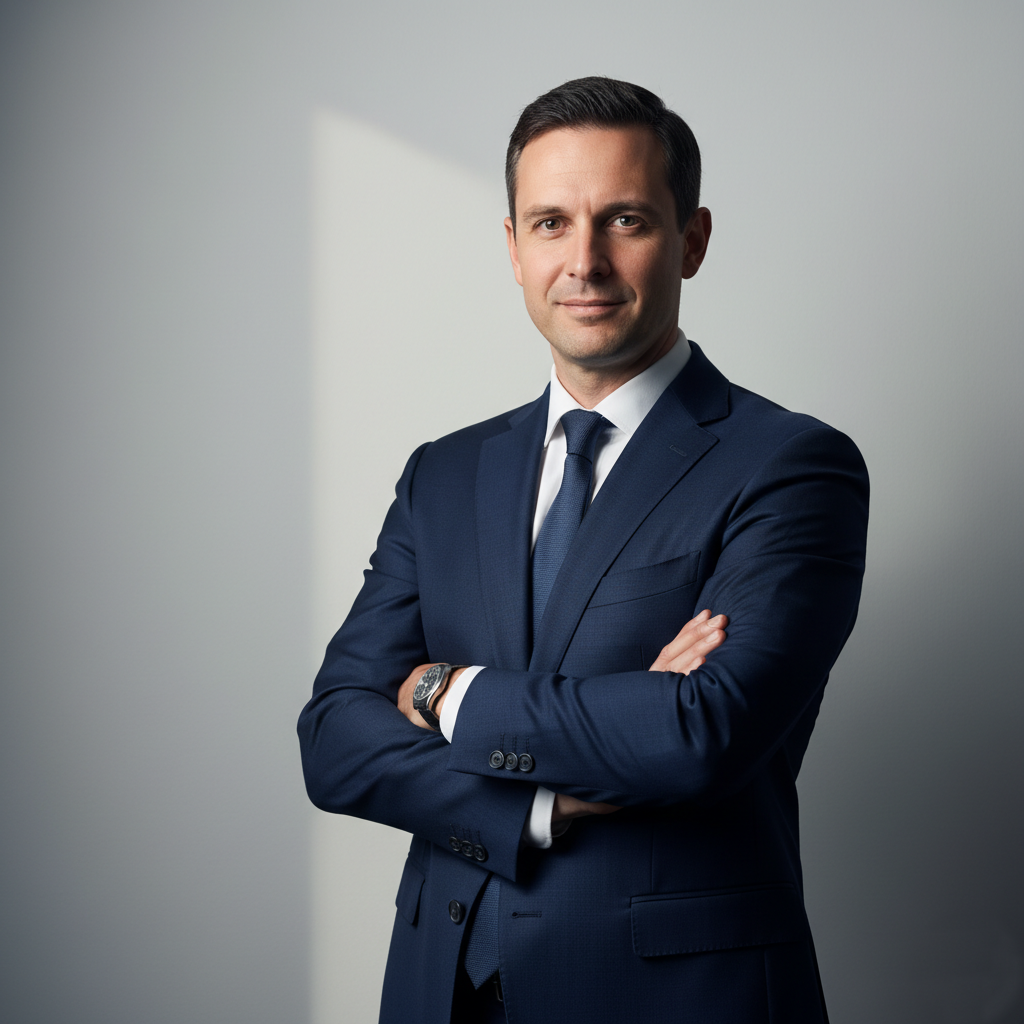Formal men’s photography is a balance between elegance, confidence, and personal expression. Beyond a well-tailored suit or good lighting, the true impact of a formal men’s photo lies in the attitude it conveys. Each pose should project confidence, professionalism, and style, without appearing stiff or unnatural. In this type of portrait, posture, gaze, and hand gestures communicate as much as clothing or the setting.
A formal photo shoot can serve various purposes: a corporate image, a professional portrait for networking, a fashion shoot, or even an artistic photograph. In all cases, the key is to capture the essence of the subject, reflecting authority and serenity simultaneously. A good pose not only flatters the figure but also helps tell a visual story: that of a man who feels secure in his role, commands the space, and projects presence.
To achieve this, the photographer’s direction and the model’s comfort are essential. Clothing should flatter posture, the setting should reinforce the message—whether it’s understated, businesslike, or contemporary—and facial expressions should flow effortlessly. Elegance, after all, isn’t forced; it manifests itself in small gestures, in the way someone holds their gaze or adjusts their jacket.
This article presents five formal posing ideas for men who want to stand out on camera with a professional, authentic, and visually appealing appearance.
1. Standing with the arms crossed.
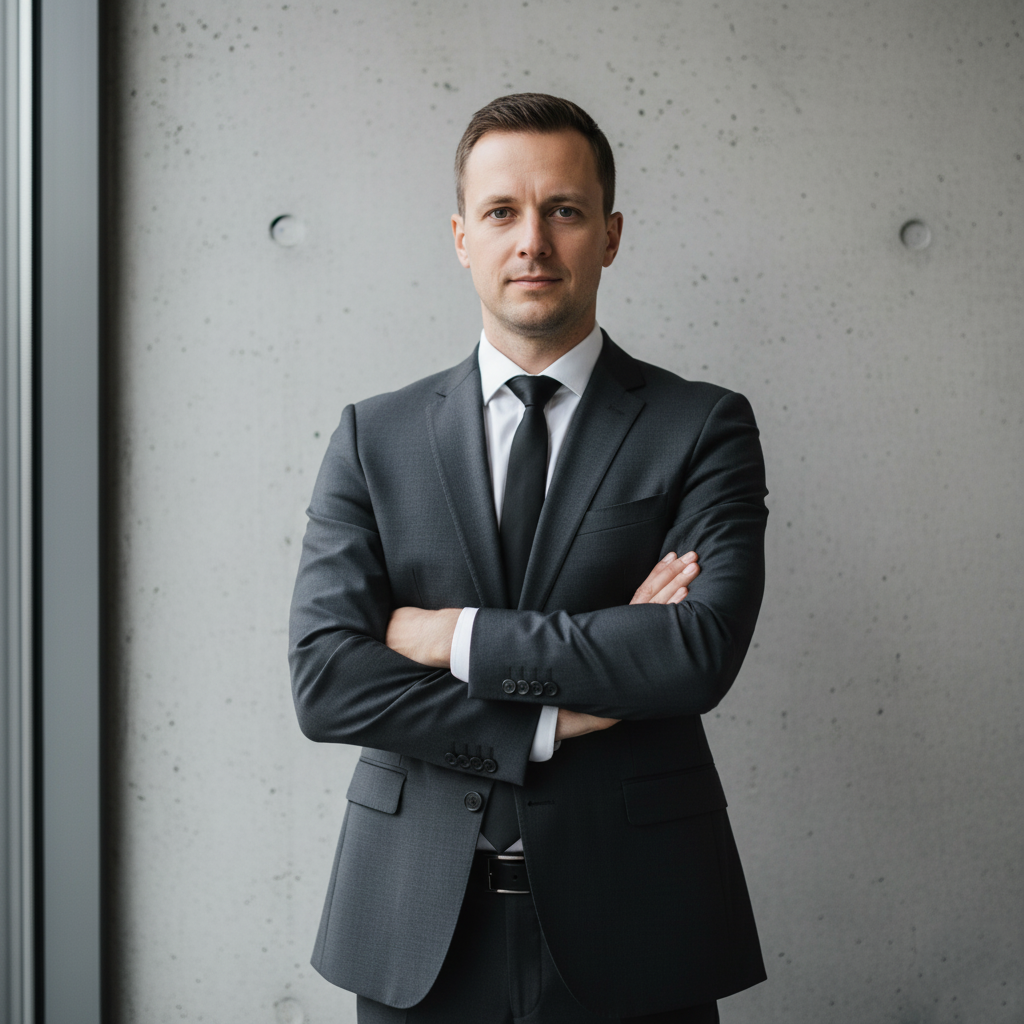
The standing pose with arms crossed is one of the most classic and effective for projecting confidence and authority. When executed well, it communicates trust without aggression, and professionalism without rigidity. The secret lies in its naturalness: relaxed shoulders, a slightly raised chin, and a serene facial expression create a balanced and powerful image. This pose works especially well in corporate portraits, professional headshots, or sessions where the goal is to highlight leadership.
To achieve an effective shot, it’s essential to pay attention to body positioning. The weight should rest on one leg, while the other is held slightly forward, avoiding excessive rigidity. The arms are crossed gently, with the hands visible or slightly concealed under the forearms. Direct eye contact with the camera conveys presence, but a slight tilt of the head can add approachability and dynamism. The lighting should come from the side or at a three-quarter angle to highlight the texture of the suit and the facial features.
The background also plays an important role. Neutral spaces or minimalist urban settings—like a plain wall or a modern office—reinforce the feeling of professionalism. This pose doesn’t require movement, but it does require attitude: the posture should reflect control, determination, and serenity.
2.Siting in a relaxing posture.
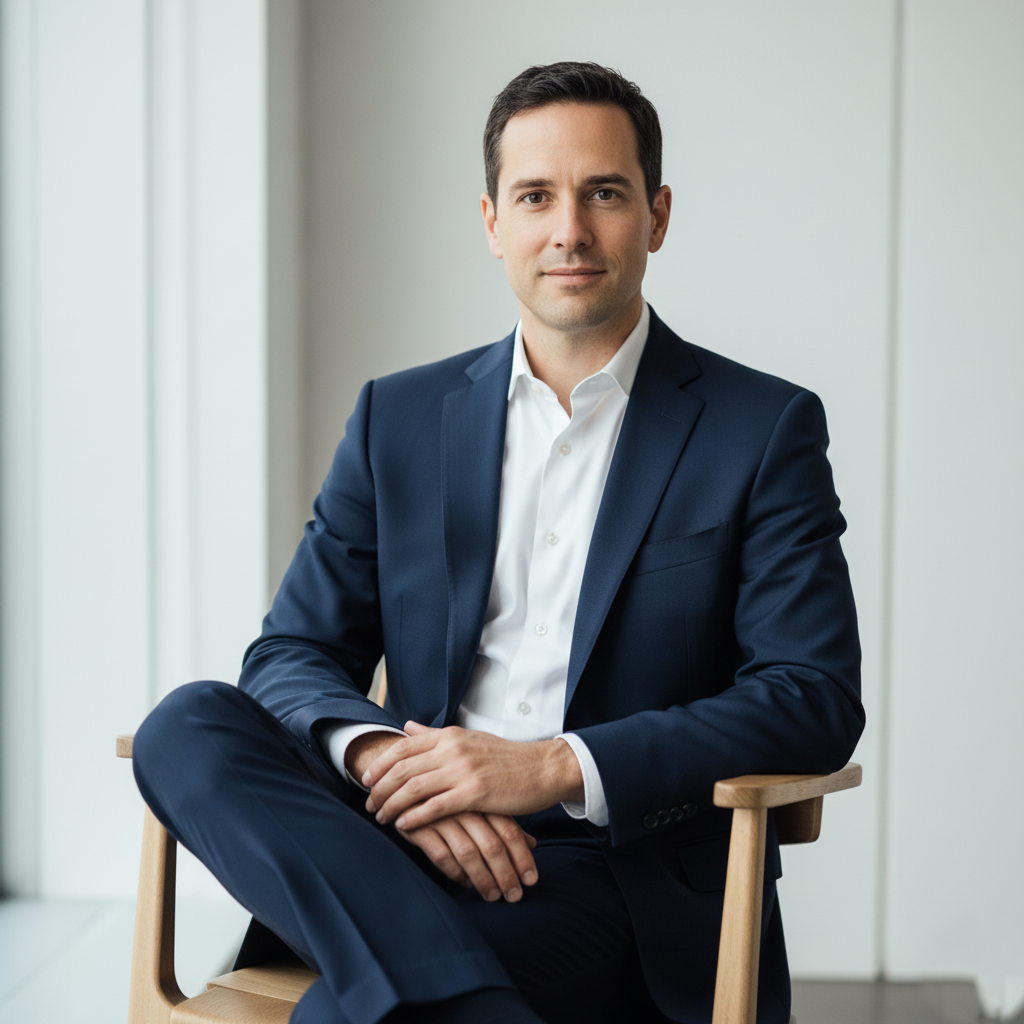
The seated pose is one of the most versatile for formal male portraits, especially when seeking a balance between authority and approachability. Sitting allows the subject to project comfort and control simultaneously, offering a more natural and less rigid image than fully standing poses. This posture is ideal for business portraits, studio photography, or sessions intended to highlight leadership without sacrificing accessibility.
The secret to this pose lies in the way the subject sits. The back should be straight, but without tension, and the shoulders relaxed. One leg can be crossed over the other or kept parallel, with the feet firmly on the ground. The hands play an important expressive role: they can rest on the legs, hold a watch, or be placed one on top of the other, displaying elegance and control. The gaze should be direct, conveying confidence, or slightly averted for a more reflective air.
The type of chair influences the composition: an armless chair or a low armchair lends clean, modern lines. The lighting, preferably from the side, should accentuate the face and suit without creating harsh shadows. It’s also important to pay attention to the folds in your clothing, as movement while seated can alter the natural drape of your jacket or trousers.
This pose works because it humanizes formality. It allows the viewer to perceive the subject as self-assured yet approachable and authentic. In a professional photograph, this balance can make the difference between a stiff image and a truly persuasive one.
3. Walking Naturally.

One of the most dynamic and attractive poses for formal men’s photos is the walking pose. This idea conveys movement, confidence, and modernity, moving away from the static portrait to show the person in action. It’s perfect for contemporary corporate photography, fashion shoots, or personal portraits that aim to project professional energy and confidence without appearing forced.
Controlled movement is key. The photographer must capture the moment when the stride looks natural, with one leg slightly forward and the arms following the body’s rhythm. The face can look straight ahead or, more casually, to the side, as if the model is focused on his own path. This pose suggests determination, purpose, and dynamic elegance—ideal traits for conveying modern leadership.
The setting should reinforce the message. An urban street, a brightly lit hallway, or a plaza in front of a building with straight lines can serve as an ideal backdrop. Natural light helps to enhance the texture of the suit and adds a touch of realism. If the shoot is indoors, soft, directional lighting will maintain the sense of movement without losing definition. The key is that the walk appears genuine, without exaggerating the pace or posture.
The power of this pose lies in its controlled spontaneity. It represents a man on the move, in progress, someone who advances with confidence and style. It’s a powerful image for those who wish to project professional dynamism without sacrificing formality.
4. In profile, looking at the horizon.
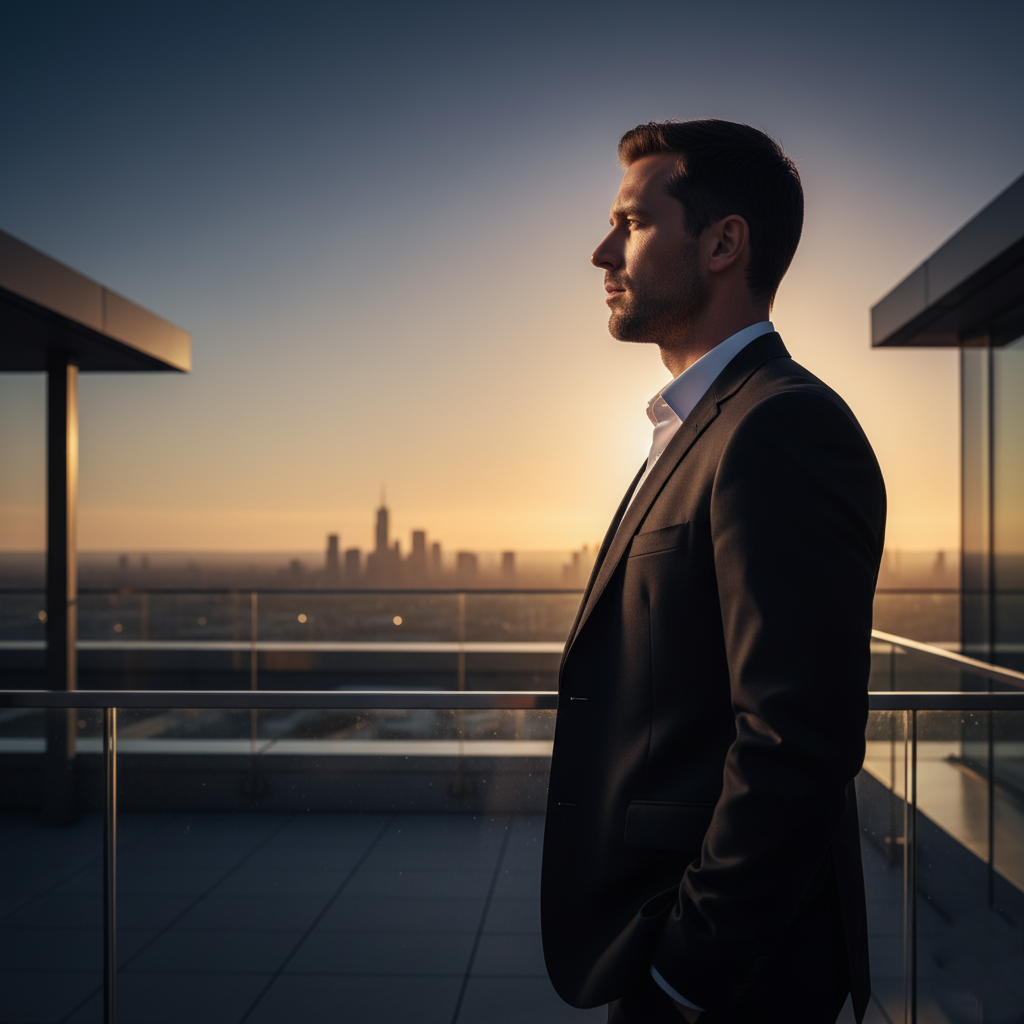
The profile pose with the look directed towards the horizon is one of the most elegant and contemplative in formal male photography. It conveys vision, confidence, and reflection, qualities that associate the subject with leadership and purpose. Unlike frontal poses, which seek a direct connection with the viewer, this posture creates a more introspective visual narrative: the man doesn’t look at the camera, but rather straight ahead, as if focused on his future or a clear objective.
The body should be upright, with the shoulders slightly back and the chin barely raised. The position of the face is key: it shouldn’t be completely in profile, but rather at a three-quarter angle, which highlights the facial features and maintains a sense of depth. The hands can remain relaxed at the sides or, for greater elegance, one can be placed in the trouser pocket. This gesture contributes to visual balance and naturalness.
Lighting plays a leading role. A beam of light from the side or backlighting helps to define the face and highlight the texture of the suit. The warm tones of sunset or soft studio lighting enhance the drama without artifice. The ideal background is a cityscape, a terrace, or an architectural space that reinforces the sense of spaciousness and perspective.
This pose not only highlights the subject’s elegance but also suggests introspection and ambition. It is the portrait of someone who observes the world with serenity and confidence.
5. Standing, adjusting the bag or dumbbells.
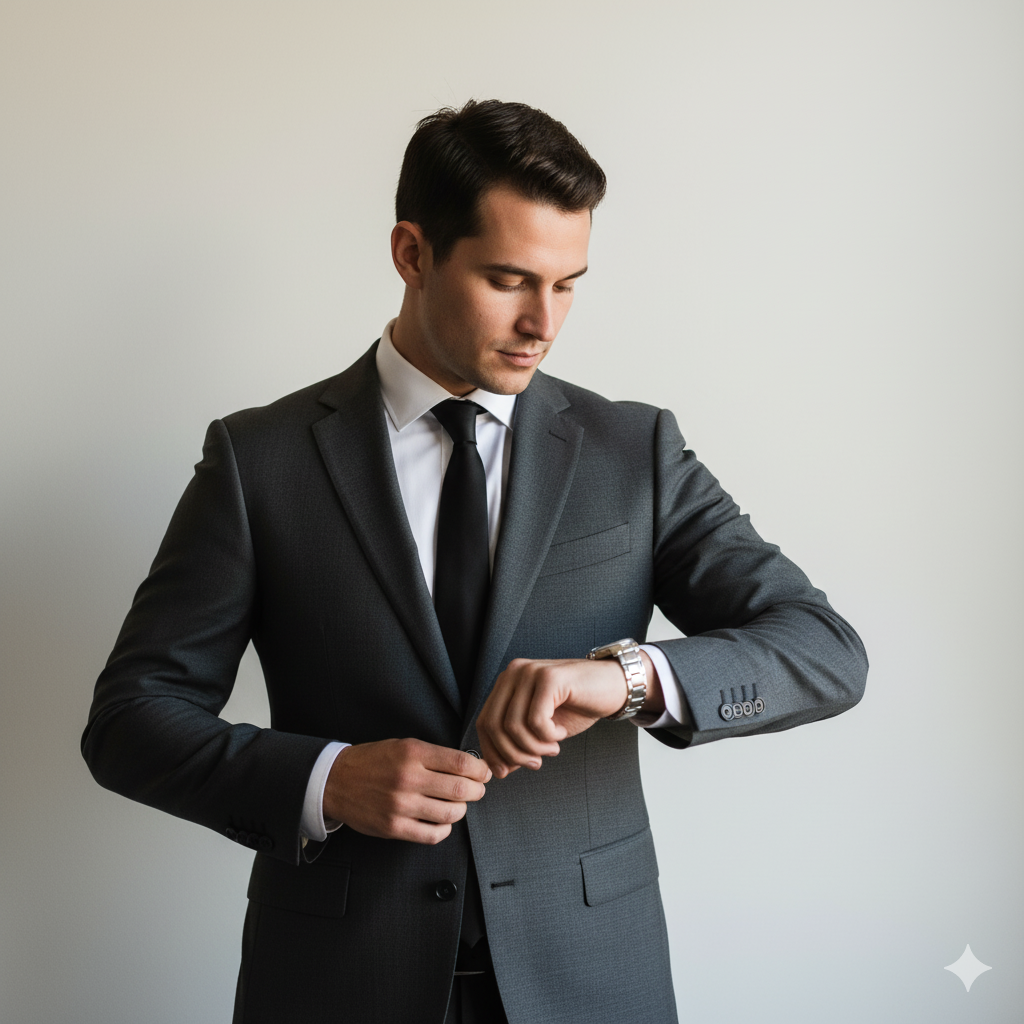
Among the most classic and effective poses for photographing a formal man is the one in which the model stands, making a subtle gesture such as adjusting his jacket, watch, or cufflinks. This type of movement projects elegance, confidence, and attention to detail—qualities associated with success and sophistication. The key is to capture the moment when the gesture appears natural, not posed, reflecting a confident attitude without arrogance.
The body should be upright, with straight shoulders and a slightly raised chin. The gaze can be directed at the camera or just barely averted, creating a sense of spontaneity. The gesture—whether buttoning the jacket, adjusting the shirt collar, or checking the cufflinks—should be fluid and authentic, as if the subject were preparing for an important meeting or public appearance.
Soft, directional lighting helps to highlight the folds of the suit, the gleam of the watch, or the metallic details of the accessories. The ideal setting might be a studio with a neutral background, an elegant office, or a space with understated textures that don’t compete with the subject. This pose works particularly well in corporate portraits and personal branding campaigns, as it conveys discipline, elegance, and confidence.
Beyond asthetics, this type of photograph tells a story: that of a man who pays attention to every detail, who prepares to stand out. It’s an image of control, determination, and refined style, reinforcing the visual identity of someone seeking to project professionalism and character.
Conclusion
Formal photographs of men aim not only to capture outward appearance but also to project a personal story of elegance, character, and authenticity. The five poses explored—from the confident, upright posture to the serene seated stance, the dynamic stride, the introspective profile, and the elegant gesture of adjusting a suit—demonstrate that formality can be expressive and diverse. Each pose offers a distinct way to convey confidence, purpose, and style, adapting to the essence of the man posing before the camera.
In formal male portraiture, the difference lies in the details: the way the gaze is held, the position of the hands, the direction of the light, or the choice of setting. A photographer who masters these subtleties can transform a simple image into a visual statement of identity. The subject, for his part, finds in each pose an opportunity to communicate without words: gesture becomes language, posture becomes narrative, and elegance is expressed through naturalness.
Formal photography doesn’t have to be rigid or distant. Conversely, when technique and emotion are balanced, an authentic portrait is achieved, capable of reflecting confidence without arrogance and presence without artifice. In a world where professional image carries so much weight, mastering the art of posing with elegance can open doors and leave a lasting impression.

